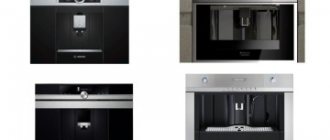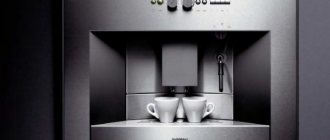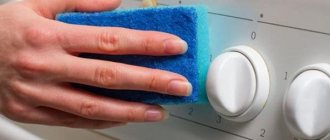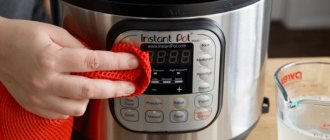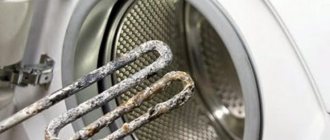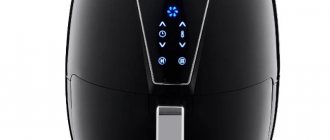For centuries, there was practically the only way to make coffee - in a Turk or cezve. Now modern devices have come to the rescue - a coffee maker, a French press, a coffee machine. The latest invention is the pinnacle of technical progress; it allows you to grind coffee beans, brew all kinds of drinks with milk and cream, and whip them. But sooner or later the owner faces a problem - descaling the coffee machine.
What is decalcification of a coffee machine
Hard water contains large amounts of calcium salts. They form a loose film on the walls of the coffee machine, which attaches to itself the salts of other metals contained in the water. Decalcification is the process of removing salt deposits.
Mechanical descaling using cleaning pastes containing abrasive particles causes serious damage to the elements of the coffee machine and can lead to serious damage. Therefore, to decalcify and clean coffee machines from coffee oils, special compositions are used that contain substances that soften and remove the scale layer.
Coffee beans contain vegetable oil, which turns into liquid form when heated . After cooling, drops of oil become thicker and accumulate on the internal elements of the coffee machine. Over time, like any other oil, it becomes rancid, giving the coffee an unpleasant taste.
Why is it necessary to clean your coffee machine?
The most expensive coffee machines need timely cleaning, because scale causes equipment failure, reducing the quality of drinks:
- the appearance of corrosion;
- changes in the taste characteristics of hot drinks;
- scale gets into the liquid, so the coffee becomes not only tasteless, but also dangerous.
Important! Scale is the result of using hard water containing calcium and magnesium. Even if you fill your equipment with high-quality distilled water, scale will still form.
How scale appears
Any drinking water, even bottled or filtered, contains a certain amount of dissolved salts, mainly calcium, magnesium, and iron compounds.
When water is heated to a boil, some of the salts precipitate , which accumulates on the walls of the coffee machine, forming scale, which leads to wear of parts and breakdown of the device. Over time, this layer becomes thicker and denser. The rate of formation of the limescale layer depends on the concentration of salt in the water.
The harder the water, the more often you will have to clean the coffee machine to remove scale.
How to descale a coffee machine with citric acid
Manufacturers offer a variety of descalers, but they are all quite expensive, and limescale must be removed every month. Large companies such as DeLonghi, Philips, Bosh produce branded cleaning products for their household appliances. You can find universal cleaners on sale, both liquid and tablets.
You cannot use descaling compounds designed to remove deposits from the surface of gas stoves or sinks; this will lead to damage to the machine. The main active ingredient in most branded products is citric acid. Many coffee machine owners have been cleaning their equipment themselves for years using a citric acid solution without causing harm to their equipment.
Citric acid has a number of undoubted advantages:
- safety for human health and the environment;
- efficiency, it removes even old scale;
- no toxic fumes when heated;
- accessibility, it is in any home;
- low price.
All this explains the popularity of citric acid as a cleaning agent for household appliances.
The main cleaning steps are the same as when using a store-bought product:
- filling the reservoir with cleaning solution;
- cleaning process;
- removal of cleaning solution;
- thorough washing.
Let's take a closer look at how to clean a coffee machine using home remedies; the instructions for servicing household appliances will help us with this.
Descaling
The main stages of descaling are the same for different types of coffee machines. It is necessary to strictly adhere to the instructions, only instead of using a special product, use citric acid, having previously diluted it in water.
If you haven’t cleaned your coffee machine for a long time and a solid layer of scale has formed, dissolve 50-100 g of citric acid in one liter of water. If you care for your household appliance regularly, a 30% solution is sufficient (proportions: 30 g of acid per 1 liter of water).
Sequencing:
- Prepare a solution, stir until the acid is completely dissolved.
- Fill the reservoir up to the mark indicating the maximum amount of liquid possible.
- Insert the container with the solution into the coffee machine and carry out the cleaning procedure, following the instructions. If your equipment does not have an automatic cleaning function, pour in the solution, wait a quarter of an hour, turn on the device by selecting the “coffee preparation” function.
- Turn off, remove the reservoir, pour out the remaining solution, rinse.
Almost all modern models have a scale formation indicator ; if you do not have such a function, descale the coffee machine with citric acid every 1-2 months, depending on the frequency of use of the household appliance and the hardness of the water.
First rinse cycle
To prevent residual citric acid from spoiling the taste of coffee, the coffee machine must be rinsed thoroughly:
Fill the tank with clean water to the maximum level, install it in the machine, select the “coffee preparation” function without adding coffee powder. The first rinse will take you 3-5 minutes.
Second rinse cycle
To completely get rid of citric acid, rinse the tank thoroughly, fill it with clean water, and repeat the “coffee preparation” mode without adding coffee itself. This completes the procedure for cleaning the coffee machine with citric acid, and the scale has been removed.
Instructions
As a rule, decalcification lasts 30-40 minutes and includes the following steps:
- removal of lime deposits;
- first rinse;
- second rinse.
Procedure:
- unplug the device from the socket;
- remove the liquid reservoir from the machine and rinse it several times with running water;
- pour the pre-prepared citric acid solution into the container, place the container in the apparatus;
- Connect the device to the power supply and start automatic cleaning. If your machine does not have this feature, leave the acid on the sides of the container for 20 minutes, then press the coffee button (without putting beans into the unit) and repeat the process until all the cleaning agent has been used up.
- Turn off the power to the appliance again, remove and rinse the liquid container. Carefully inspect the walls of the tank: if there are traces of scale on them, repeat the decalcification procedure 1-2 more times.
- Fill the unit container with clean water to the maximum allowable level and start the brewing mode.
- Repeat the rinsing step of the coffee machine again.
IMPORTANT! Depending on the degree of water hardness in the region where you live, it is advisable to clean the electrical appliance at least once every 3-6 months (every 150-250 servings of drink).
How to descale a coffee maker with vinegar
Vinegar is a natural cleaning agent that removes limescale and grease residue well; it is often used to descale coffee machines at home, along with citric acid.
Cleaning method:
- Prepare a cleaning solution: add 2 parts water to 1 part vinegar.
- Pour the solution into the water container, insert it into the coffee machine, and turn on the cleaning mode. If there is no such mode, select the “coffee preparation” function.
- After turning off the household appliance, wait 15–20 minutes for the scale to dissolve better
- Rinse the tank, fill with clean water, and bring to a boil as you would brew coffee. Drain the water and repeat the procedure.
When heating, vinegar vapors are very unpleasant for humans; open a window for ventilation.
How often should you descale?
To know when and how to descale your coffee machine with citric acid, you should consider several factors. The frequency between descaling cycles depends on two main points:
- The level of calcium and magnesium salts present in the water (depending on the area where you live).
- Number of cups of coffee prepared.
Most modern coffee machines are equipped with indicators that indicate the descaling time. In this case, you just need to carry out the cleaning procedure.
If the equipment does not have such a function, calcified formations should be removed at least once every two months or after 200-300 cups of brewed drink, regardless of whether brewing water or frothed milk is used.
Cleaning with decalcifiers
All manufacturers of household appliances recommend using descaling products offered by the same company to descale your coffee machine. This is indicated in any instructions. However, all products are created using the same technology and have a similar composition. They are available in both liquid and tablet form:
- Not everyone can afford to clean a coffee machine using DeLonghi Branded products are of high quality and guarantee excellent results.
- Cleaning a coffee machine with Saeco descaling agent is cheaper, but it is almost as good in terms of quality.
- Other companies offer their own cleaning products to care for household appliances.
DeLonghi
Saeco
Cleaning the device from coffee oils
Removing coffee oils means cleaning the hydraulic system of the coffee machine. The method depends on the type of device.
Pour-type coffee machine
Operating procedure:
- Disconnect the removable brewing device and rinse with running water.
- Clean the strainer holes clogged with coffee residues using a soap solution, brush or needle.
- Install the element back after it has completely dried.
Cleaning using special means (both removable and non-removable brewing unit) is carried out in strict accordance with the instructions for the device. Typically, the algorithm is as follows:
- Place an oil remover tablet into the ground coffee chamber.
- Install the “Ground Coffee” program.
- Place a cup under the dispenser and activate the largest volume of espresso brewing.
- Drain the released water (as a rule, the liquid comes out white and with a foam similar to soap).
- Prepare coffee 2-3 times, but do not drink it, but pour it into the sink.
- After 30 minutes, repeat the procedure 2-3 times with clean water.
Products for cleaning coffee machines from oils
Cleaning from coffee oils is carried out using tablets with the appropriate markings: cleans, clean, cleaning, for cleansing coffee oils, etc. Judging by the reviews, they have proven themselves well:
- Topperr 3037,
- JURA,
- Melitta 1500791,
- Bosch 311769,
- Cleancaf Urnex,
- Neohome,
- Filtero 613 and others.
The most affordable coffee oil tablets are produced by Melitta and Bosch. On average, one cleaning costs 250 rubles. It’s even cheaper to buy similar products from Topper 3037 (35–40 rubles per cleaning).
Video: cleaning the device from coffee oils (using Jura as an example)
Espresso machine
Carob-type coffee makers are cleaned of oils as follows:
- Pour cleaning powder into the blind filter or place a tablet in the holder.
- Install the portafilter into the brew group.
- Turn on the spill cycle for 10 seconds.
- Repeat the sequence (turn on the spill - turn off - wait) 5 times. After this, water should be discharged from the brewing group into the drip tray, which is accompanied by a characteristic sound of water being drained.
- Loosen the horn, but do not remove it from the brew group head.
- Turn on the water supply: the liquid will put pressure on the blind filter and will soon begin to overflow. At this point, you need to start tilting and rotating the horn for more effective cleaning.
- Take out the portafilter and start pouring water to wash the divider; rinse the holder itself with running water.
- Repeat steps 1–6 with clean water without a special product to clean the system of chemicals.
- Clean the threads of the group head and the edges of the dispersion screen using a toothbrush.
- Wash parts.
If necessary, the holder, filter and tube tip are cleaned by soaking in the solution:
- Dilute the cleaning powder in water (see dosage in the instructions for the specific product).
- Immerse the parts in a container with the solution for half an hour.
- Clean off dirt and rinse thoroughly in plenty of running water.
What tools to use
Typically, powders are used to remove oils in carob coffee machines, for example:
- JOEGLO "Espresso machine cleaner"
- ASCACO "Cleaning agent for removing coffee oils from espresso coffee machine elements",
- PULY POWDER Plus “Cleaning agent for espresso coffee machines”,
- Urnex Cafiza 2 “Cleaning agent for espresso machines.”
There are also products in tablet form, for example Cafiza E16 “Cleaner for espresso machines and super-automatic machines”.
What happens if the coffee machine is not cleaned?
Any water other than distilled water contains minerals and chemical elements. The main one is calcium. When water is heated, calcium salts precipitate, forming limescale.
The surface of the scale is porous; salts of other metals settle on it, and over time, microorganisms can multiply in these pores. All this negatively affects the technical condition of the household appliance and the taste of coffee.
The main signs of scale appearance:
- change in the smell of the drink, it becomes unpleasant;
- getting cereal into a cup;
- the feeling that the coffee has not been brewed enough, its strength has become less;
- reduction of steam pressure;
- weakening of the drink stream, this applies to a lesser extent to coffee machines with a boiler as a heating element; the likelihood of blockages is lower than for models equipped with a thermoblock;
- changing the sound of the coffee machine during operation.
Some modern appliances are equipped with sensors for automatically checking the scale level; a notification appears on the panel that the coffee machine needs to be decalcified. This warning must not be ignored. Even if automatic blocking does not occur, the device may soon fail.
